Liquefying Cleansing Creams
The first cosmetic cleansing cream to be manufactured on an industrial scale was cold cream, an emulsion made with mineral or almond oil along with beeswax, borax and water.
Also see: Cold Creams
A second type of cleanser was introduced around 1920 (deNavarre, 1941). It was made solely from oils and waxes, so was water-free (anhydrous) and not an emulsion. Cleansers of this type were designed to melt or liquefy when applied to the skin – they were thixotropic – which is why they were referred to as liquefying cleansing creams.
Like cold creams, liquefying cleansing creams came in a wide range of formulations; but the cleansing ingredient in all of them was mineral oil. This suggests that the idea for these creams came from the acting profession where mineral oil was used by some to remove greasepaint. Early forms were made with only two ingredients: mineral oil and paraffin wax.
(parts by weight) Mineral oil 65/75 80 Ozokerite 78°C 20 (deNavarre, 1975, p. 350)
Later forms added petrolatum.
Mineral oil 65.0 Petrolatum 15.0 Paraffin 20.0 (Kalish, 1937, p. 67)
The three parts of this mixture worked together to produce a cream that was firm in its container but liquefied as soon as it was applied to the skin:. The paraffin wax made the product firm in the jar, the mineral oil formed the liquid skin cleanser when the cream liquefied, and the petroleum jelly kept the paraffin wax and mineral oil from separating – a process known as ‘bleeding’ – when standing and helped to make the cream more viscous so that it did not run off the face when it liquefied.
Other waxes like ceresin or spermaceti could also be used to firm the mixture. As the product was very temperature sensitive, the combination of ingredients, the materials selected, their grade (viscosity), and the proportion of wax-to-oil, all had to be carefully controlled if the cleanser was to function properly.
Ceresin 64°C 18 parts Petrolatum 49/50°C 15 parts Spermaceti 5 parts Mineral oil 65/75 62 parts Perfume qs 100 parts Directions: Melt the waxes first, then added petrolatum if any, and finally the liquid materials. Be certain the mixing is thorough, perfume at 45°C and pour into jars.
Filling: Fill the jars ¾ full at first, and allow to get almost cold. Then go back (reheating some of the cream if needed) and fill the jars to the top. This is called “topping,” and by doing so the depression found in the middle of the mass will be obviated. It is recommended that jars be warmed to 37-40°C before filling with cream as this prevents bubble formation and contraction of the mass away from the jar walls.(deNavarre, 1941, p. 270)
Opaque creams
Liquefying cleansing creams were generally translucent, either plain or tinted. This was used as a point of difference between them and cold creams which, by comparison, were sometimes described as ‘heavy’ or ‘solid’ and more like grease or lard.
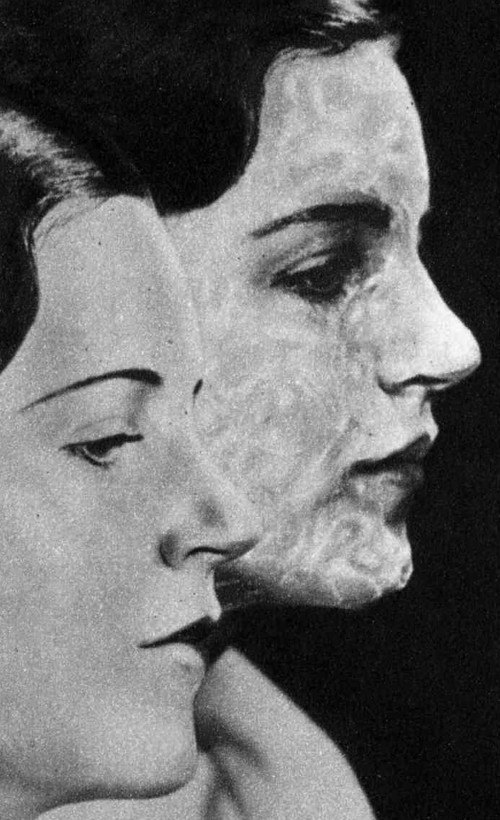
Above: 1931 A translucent liquefying cleansing cream (left) compared with a white, opaque cold cream (right) as applied to the face.
However, it was possible to make an opaque version and some manufacturers did so, either by adding small amounts of a whitening agent like zinc oxide or titanium dioxide, or by including ingredients like magnesium stearate or zinc stearate; the latter having the added value of stiffening the cream and reducing bleeding (Hilfer, 1939, p. 47).
Cleansing ability
Skin cleansers need to remove dirt, sebum, dead skin cells, bacteria and make-up – collectively known as soil – that is loosely bound to the skin by film of oil. Liquefying cleansing creams worked by dissolving the oil film that held the soil to the skin, so that it could be wiped off with a cloth or tissue. Given their oily nature, it seems likely that most women followed them with a soap-and-water wash or removed any remaining oily residue with a skin tonic or freshener.
As liquefying cleansing creams functioned in much the same way as cold creams, there was a good deal of discussion amongst cosmetic chemists as to which was the better cleanser. Some argued that cold cream was less effective because it cooled the skin which closed the pores, thereby preventing it from penetrating them and deep cleansing.
The pores of the skin are like little thermostats; they expand with heat and contract with cold. Now when a cream containing a high percentage of water is applied to the skin it is obvious that the pores will at once contract and prevent the deep penetration which is essential if the skin is to be thoroughly cleansed. Some chemists who favor cold cream type cleansers argue that such a reaction is momentary and that with continued rubbing the skin warms up and the pores open again. But they overlook the simple fact that water begins to evaporate immediately upon exposure and in evaporating it abstracts heat from the skin, which causes the pores to contract again.
(Cleansing creams, 1933, p. 366)
As we now know the pores of the skin do not open and close in this manner so this argument is specious. Others thought the main advantage of liquefying cleansing cream was their lower viscosity.
Whether or not liquefying cleansing cream is superior to cold cream as a cleanser is a matter of some controversy. One fact is certain: the cream is applied with less effort and pressure; therefore having a greater tendency to float dirt instead of rubbing it into the skin. …
Theoretically, a liquid with a low surface tension has a tendency to float into every crevice and under dirt particles, rather than float over the top of them as a high surface tension liquid does. In addition, there seems to be evidence accumulated to the effect that oils with a low viscosity have a greater penetration than those with high viscosity.(deNavarre, 1934, p. 79)
A third argument viewed liquefying cleansing creams as superior because they did not required as much massaging as cold creams so were less likely to ‘stretch the skin’.
Our original cleansing cream many years ago was the old fashioned cold cream. It was hard and stiff and required much manipulation before it was sufficiently worked into the pores. This type brought about stretching and sagging especially in delicate fine pored skins and quickly fell into disrepute. Later came the vogue of the quick liquefying cream, usually a perfumed mineral jelly, that is to say a mixture of paraffin, mineral jelly and mineral oil. These creams had the great advantage of liquefying rapidly at skin temperatures, giving rapid and good cleansing without the necessity of manipulation and massage.
(Ast, 1937, p. 354)
Although none of these arguments seems particularly convincing today, at the time they held some sway and cosmetic companies used them in their advertising.
Why Take Chances with “Heavy” Cleansing Creams
that go on skin like lard
When there’s a remarkable new liquefying cream that melts at skin heat? The name of this new cream creation is Hinds Cleansing Cream.
The moment you apply, it melts, penetrates pores, removes all dirt, dust, make-up.
Observe how gently it frees skin of impurities, leaving it clean and soothed.
Thus you avoid the danger of pore enlargement which comes with heavy cleansing creams that require vigorous rubbing to penetrate.
This new cream melts 2 to 7 times faster than other popular priced liquefying cream. Chemists have proved this.(Hinds advertisement, 1931)

Above: 1930 Hinds compares traditional cold cream and their liquefying cream.
Problems
Some women found that liquefying cleansing creams irritated their skin. This may have been due to a poor selection of perfume. The creams were anhydrous so there was no water to moderate the action of aromatics which could lead to irritation.
The writer has often heard women complain to toilet goods salesgirls that their skin burns after applying a certain liquefying cream. … Such burning is not confined to liquefying creams alone. True, a liquefying cream is slightly dehydrating, and might tend to irritate a dry skin. But it is probably the perfume that is doing it. Refrain from using aromatics containing aldehydes, ketones, phenols and their esters, as these may sting the skin. Special oils for this purpose without the burning ingredients are available, and are suggested in place of the usual perfumes.
(deNavarre, 1934, pp. 79-80)
A second problem was that the creams had a tendency to melt in the jar when they got warm during the hotter summer months. This problem was not peculiar to liquefying cleansing creams but required alterations in formulations for creams sold in places that had warmer climates.
A more general concern was that the creams worked so well in removing oils that many women found that they had a unacceptable drying effect on their skin.
The solvent action of the cream on the dirt and oil in the pores was so excellent that it did too good a job. Dry skins felt this effect quite markedly. The resulting removal of natural fats aggravated the condition of a dry skin, and we find many women unable to use liquefying cleansing creams because of this drying effect.
(Ast, 1937, p. 354)
In an attempt to ameliorate their drying effect and harshness, some cosmetic companies added substances to renew the fats and oils removed by the cleanser such as lanolin, absorption bases, cholesterol and lecithin.
Mineral oil 65.0 Hydrous lanolin 15.0 Petrolatum 10.0 Ozokerite 10.0 (Hilfer, 1939, p. 47)
There were other additions to these creams as well; for example, when Pond’s added vitamins to its skin creams it included them in its Liquefying Cream for good measure.
Given their ability to remove oil, liquefying cleansing creams were often recommended by cosmetic companies or beauty experts for oily skin something most people would find unacceptable today. For example, as late as 1959, Dorothy Gray was recommending Dorothy Gray Cleansing Cream (Liquefying) for oily skin, Dorothy Gray Dry Skin Cleanser for dry skin and Dorothy Gray Salon Cold Cream for normal and combination skin.
The “quick-liquefying” creams, which consist entirely of mineral oils and paraffin waxes, are easily recognized by their translucent appearance. They melt quickly and spread easily but are not so efficient as cleansers for all kinds of grime, and are eventually drying to the skin. They are best used, therefore, by women with oily skin. There popularity, however, seems to be declining.
(Heuer, 1943, p. 7)
Another argument for using Liquefying Cleansing Creams on oily skins was that as mineral oils would not penetrate the skin, they would not increase the skin’s oil production.
Decline
Although some companies persisted with them well into the 1950s, after 1935, liquefying cleansing creams fell out of favour (deNavarre, 1975). The harshness of the mineral oil was one factor, as was the introduction of lighter-feeling cleansing lotions that used new developments in surfactants. I would also note the increased interest in medicated cleansers for oily skin that followed the rise of the adolescent market in the 1950s and the ‘youth quake’ of the 1960s.
First Posted: 9th September 2013
Last Update: 5th November 2021
Sources
Ast, M. (1937). Cleansing creams for dry skin. The Drug and Cosmetic Industry. 40(3), 354-355.
Cleansing creams. (1933). The Drug and Cosmetic Industry. 33(4), 366-367, 404, 406.
deNavarre, M. G. (1934) Liquefying Creams. The American Perfumer & Essential Oil Review. April, 79-80.
deNavarre, M. G. (1941). The chemistry and manufacture of cosmetics. Boston: D. Van Nostrand Company.
deNavarre, M. G. (1975). The chemistry and manufacture of cosmetics (2nd ed., Vol. IIII). Boston: D. Van Nostrand Company.
Harry, R. G. (1944). Modern cosmeticology. (2nd ed.). London: Leonard Hill.
Heuer, L. A. (1943). Cosmetics. (Rev. ed.). Chicago: Household Finance Corporation.
Hilfer, H. (1939). Cleansing creams. The Drug and Cosmetic Industry. 45(1), 42-43, 47.
Hifer, H. (1948). Cosmetics. Functions and formulations. Cold and cleansing creams. The Drug and Cosmetic Industry. 62(2), 176-177, 274-275.
Kalish, J. (1937). Tested formulas: Cleansing creams. The Drug and Cosmetic Industry. 40(1), 66-67, 69.

1922 Melba Skin Cleanser.
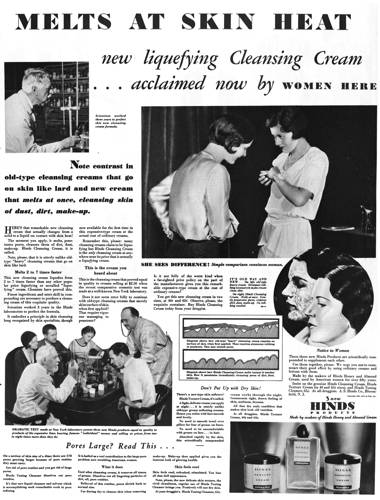
1930 Hinds Skin Cleanser.

1931 Boyer’s Skin & Pore Cleanser.

1932 Kathleen Mary Quinlan Cleansing Cream.
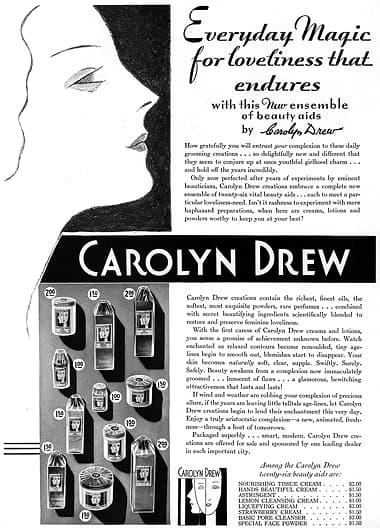
1932 Carolyn Drew products including a Liquefying Cream.
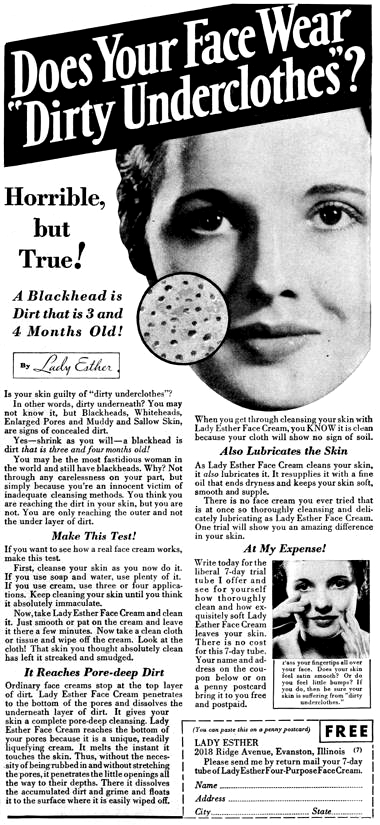
1934 Lady Esther Face Cream.
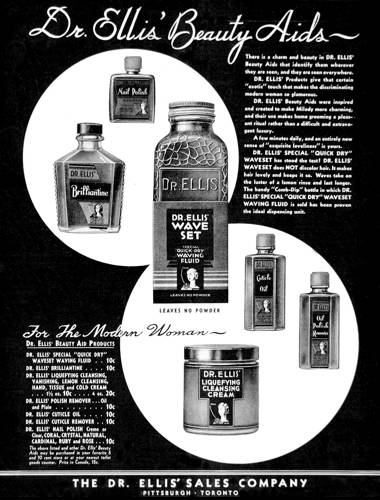
1935 Dr. Ellis Liquefying Cleansing Cream.
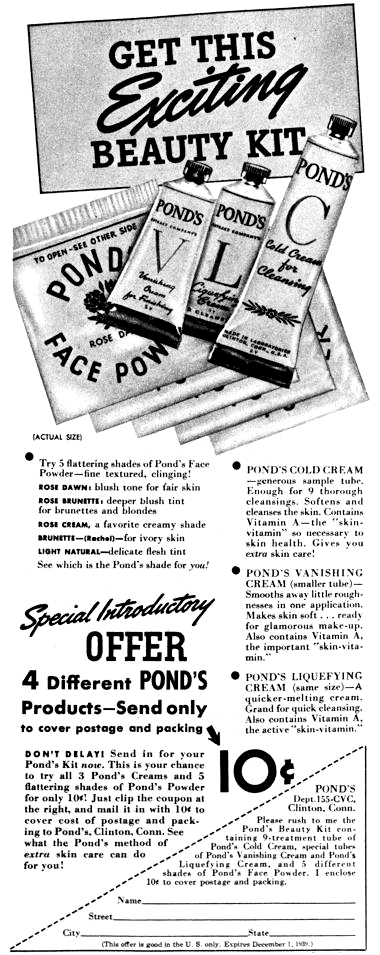
1939 Pond’s Liquefying Cream with vitamins.
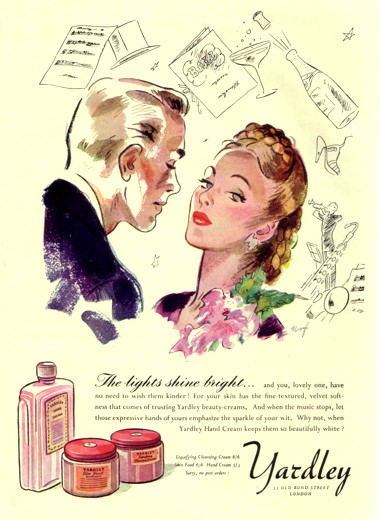
1946 Yardley Hand Cream (bottle), Skin Food and Liquefying Cleansing Cream.
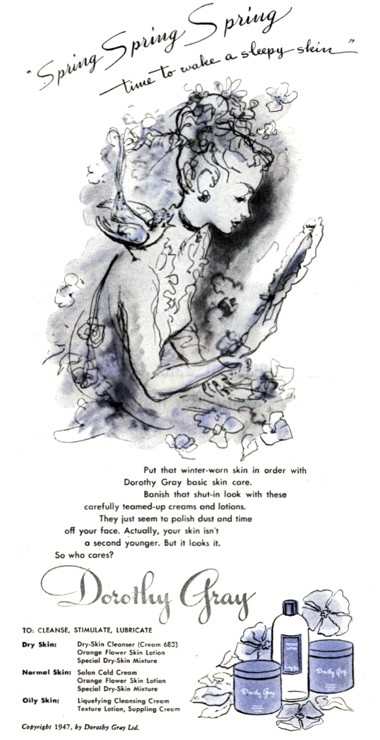
1947 Dorothy Gray Liquefying Cleansing Cream for oily skin.
